|
| |
Archives
a couple of pictures
Here are a couple of pictures taken with the Flexaret Va. 1. I like the square format. 2. It makes a nice street camera because people don't realize you are taking pictures of them. These two were on the same role as the pano. Taken at the Village Bakery in Langley. (Their tomato Panini sandwiches are *great*.) These pictures are just having fun.
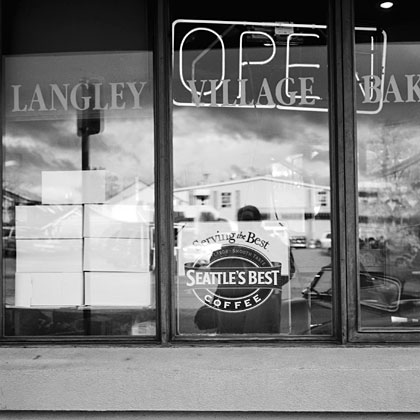

|
Wednesday February 9 2005
|
panos
I've been working on panos for 13 years. It's been slow. Life and not quite right equipment kept getting in the way. The equipment was not bad but it didn't do what was in my mind so it's been a series of false starts. Not totally false. I've learned a little each time.
I went out a couple of days ago with the "new" 1960 Meopta Flexaret Va twin lens reflex loaded with Ilford XP2, the pano head I bought 13 years ago, and did this picture.

Priv te Restrooms, Langley, Feb., 2005
medium image (193x800)
large image (500x2070)
I'm so excited I could pee my pants. This is a 5 panel pano covering 150 degrees. Panavue Image Assembler seemed to stitch it just fine. (I still have to go over it with a fine tooth comb.) And the Flexaret Va has a pretty sharp lens. See that door on the left of the dark building with three doors? There is a sign on that door. Here is the sign at the scanning limit of my Epson 2450.
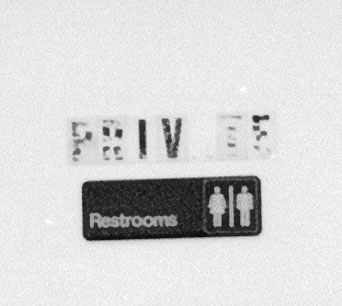
A better scanner would get more detail. Stitching 5 negatives together is the same as having one negative 2 1/4 inches by 11 1/4 inches.
This is a rough image. It needs some serious spotting and some more levels adjusted but does what I wanted it to do. There is certainly a bit of serendipity in a picture like this but it all came together and gives me some direction to go in. IT WORKED! And it really feels good when it does work.
iraq
Stories from Fallujah
|
These are the stories that will continue to emerge from the rubble of Fallujah for years. No, for generations…
Speaking on condition of anonymity, the doctor sits with me in a hotel room in Amman, where he is now a refugee. He’d spoken about what he saw in Fallujah in the UK, and now is under threat by the US military if he returns to Iraq.
“I started speaking about what happened in Fallujah during both sieges in order to raise awareness, and the Americans raided my house three times,” he says, talking so fast I can barely keep up. He is driven to tell what he’s witnessed, and as a doctor working inside Fallujah, he has video and photographic proof of all that he tells me.
“I entered Fallujah with a British medical and humanitarian convoy at the end of December, and stayed until the end of January,” he explains, “But I was in Fallujah before that to work with people and see what their needs were, so I was in there since the beginning of December.”
When I ask him to explain what he saw when he first entered Fallujah in December he says it was like a tsunami struck the city.
“Fallujah is surrounded by refugee camps where people are living in tents and old cars,” he explains, “It reminded me of Palestinian refugees. I saw children coughing because of the cold, and there are no medicines. Most everyone left their houses with nothing, and no money, so how can they live depending only on humanitarian aid?”
The doctors says that in one refugee camp in the northern area of Fallujah there were 1,200 students living in seven tents.
“The disaster caused by this siege is so much worse than the first one, which I witnessed first hand,” he says, and then tells me he’ll use one story as an example.
“One story is of a young girl who is 16 years old,” he says of one of the testimonies he video taped recently, “She stayed for three days with the bodies of her family who were killed in their home. When the soldiers entered she was in her home with her father, mother, 12 year-old brother and two sisters. She watched the soldiers enter and shoot her mother and father directly, without saying anything.”
The girl managed to hide behind the refrigerator with her brother and witnessed the war crimes first-hand.
“They beat her two sisters, then shot them in the head,” he said. After this her brother was enraged and ran at the soldiers while shouting at them, so they shot him dead.
“She continued hiding after the soldiers left and stayed with her sisters because they were bleeding, but still alive. She was too afraid to call for help because she feared the soldiers would come back and kill her as well. She stayed for three days, with no water and no food. Eventually one of the American snipers saw her and took her to the hospital,” he added before reminding me again that he had all of her testimony documented on film.
| |
[more]
Sistani begins on his true agenda
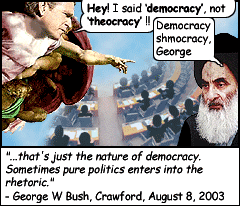
|
As expected, the United Iraqi Alliance (UIA) is emerging as the dominant party, making its chief mentor and spiritual adviser, Grand Ayatollah Ali al-Sistani, the clear winner of the Iraqi elections of January 30 (see Note below). Only US President George W Bush and his tight-lipped advisers know whether this is the beginning of the United States' nightmare in Iraq. Sistani never had any doubts about what he wanted: use the much-cherished democracy of the US invaders to enable his people - the Shi'ites - to emerge as governors of Iraq, after years of being
marginalized by the minority Sunnis. The most dominant question is how Islamic the emerging government of Iraq is likely to be.
| |
[more]
The Republicans' Iraq and the Islamic Republic of Iraq
|
The Republican Party spin machine was bouncing around the airwaves like an overloaded washing machine on Sunday attempting to obscure from the American public that they had by their actions managed to install a Shiite religious ruling class in Iraq. The New York Times even lead with a headline, "U.S. Officials Say a Theocratic Iraq Is Unlikely." This headline is probably wrong, but in any case it begs the question of what a "theocracy" is.
| |
[more]
Shia and Kurds poised to dominate Iraqi government
|
Negotiations between the successful parties in the Iraqi election will start shortly and are likely to produce a national unity government dominated by the Shia and the Kurds, according to Hoshyar Zebari, the Foreign Minister.
| |
[more]
Law of Unintended Consequences
Careful What You Wish for in Iraq
|
In a heightened display of saber rattling, President Bush, Vice President Dick Cheney and Secretary of State Condoleezza Rice have been saying nasty things about Iran's "unelected mullahs."
This is apparently so we'll be able to tell the difference between the theocracy in place in Tehran and the one coalescing in Baghdad. Although things are looking slightly brighter for Iraq after its debut election, it is still not clear why the United States has spent incalculable fortunes in human life, taxpayer money and international goodwill to break Iraq and then remake it in the image of our avowed "axis of evil" enemy next door.
| |
[more]
The Unfeeling President
|
I fault this president for not knowing what death is. He does not suffer the death of our 21-year-olds who wanted to be what they could be. On the eve of D-Day in 1944 General Eisenhower prayed to God for the lives of the young soldiers he knew were going to die. He knew what death was. Even in a justifiable war, a war not of choice but of necessity, a war of survival, the cost was almost more than Eisenhower could bear.
But this president does not know what death is. He hasn't the mind for it. You see him joking with the press, peering under the table for the weapons of mass destruction he can't seem to find, you see him at rallies strutting up to the stage in shirt sleeves to the roar of the carefully screened crowd, smiling and waving, triumphal, a he-man.
| |
[more]
photography
Japanese Old Photographs in Bakumatsu-Meiji Perioid
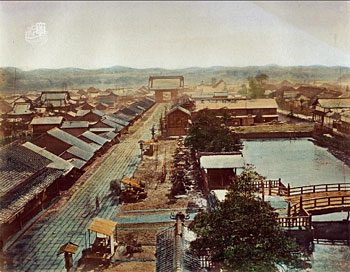
[more]
thanks to Pretty Serendipities

PM invites Abbas to visit his Negev ranch
|
Prime Minister Sharon on Tuesday invited Palestinian Authority Chairman Mahmoud Abbas to visit his ranch in the Negev desert, an offer which the Palestinian leader accepted. The prime minister also said he would be willing to visit the PA leader in Ramallah.
The invitation came during the Sharm el-Sheikh summit, hosted by Egyptian President Hosni Mubarak, and Jordanian King Abdullah, and attended by the Israeli and Palestinian leaders. Both leaders announced an agreement to end more than four years of hostilities between Israel and the Palestinians.
Echoing the words of Palestinian Authority Chairman Mahmoud Abbas moments before, Prime Minister Ariel Sharon on Tuesday
"Today, in my meeting with Chairman Abbas, we agreed that all Palestinians will stop all acts of violence against all Israelis everywhere, and, at the same time, Israel will cease all its military activity against all Palestinians everywhere," Sharon said at the close of a day-long summit in the Red Sea resort town.
| |
[more]
Deal to end Palestinian uprising
|
Israel and the Palestinians are to announce a deal to end more than four years of bloody intifada, which has claimed over 4,500 lives, with ceasefire declarations today.
| |
[more]
Deja Vu or Not part I
|
The flags of Israel, Palestine, Jordan and Egypt are very familiar with the routine. Once every few months or years, when a historic event is held at Sharm el-Sheikh, they are pulled out of old boxes and hung for several hours on metal poles to mark the convening of another summit. When the meeting ends, they are folded up again and smeared with another layer of cynicism that preserves them well - until the next event.
| |
[more]
No border between Yesha and the IDF
By Gideon Levy
|
The Israel Defense Forces must disengage from the settlers now. This process of disengagement will be difficult - the IDF is deeply invested in the settlement enterprise - but it is obligated by reality. Even before a single settler family is evacuated, the army must untie its Gordian knot with the settlers, which has bound it for many years. The time has come for it to again be the Israel Defense Forces, as intended, rather than the Settler Defense Forces, as it has been throughout the long years of occupation.
| |
[more]
poster art
American Social Hygiene Posters
ca. 1910-1970
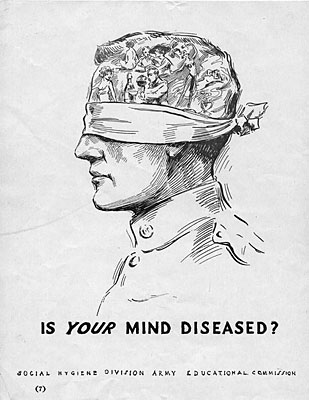
[more]
thanks to plep
fascism
Hunger for Dictatorship
War to export democracy may wreck our own.
|
Students of history inevitably think in terms of periods: the New Deal, McCarthyism, “the Sixties” (1964-1973), the NEP, the purge trials—all have their dates. Weimar, whose cultural excesses made effective propaganda for the Nazis, now seems like the antechamber to Nazism, though surely no Weimar figures perceived their time that way as they were living it. We may pretend to know what lies ahead, feigning certainty to score polemical points, but we never do.
Nonetheless, there are foreshadowings well worth noting. The last weeks of 2004 saw several explicit warnings from the antiwar Right about the coming of an American fascism. Paul Craig Roberts in these pages wrote of the “brownshirting” of American conservatism—a word that might not have surprised had it come from Michael Moore or Michael Lerner. But from a Hoover Institution senior fellow, former assistant secretary of the Treasury in the Reagan administration, and one-time Wall Street Journal editor, it was striking.
Several weeks later, Justin Raimondo, editor of the popular Antiwar.com website, wrote a column headlined, “Today’s Conservatives are Fascists.” Pointing to the justification of torture by conservative legal theorists, widespread support for a militaristic foreign policy, and a retrospective backing of Japanese internment during World War II, Raimondo raised the prospect of “fascism with a democratic face.” His fellow libertarian, Mises Institute president Lew Rockwell, wrote a year-end piece called “The Reality of Red State Fascism,” which claimed that “the most significant socio-political shift in our time has gone almost completely unremarked, and even unnoticed. It is the dramatic shift of the red-state bourgeoisie from leave-us-alone libertarianism, manifested in the Congressional elections of 1994, to almost totalitarian statist nationalism. Whereas the conservative middle class once cheered the circumscribing of the federal government, it now celebrates power and adores the central state, particularly its military wing.”
| |
[more]
thanks to BookNotes
photography
J.C. Coovert
Photographer of the Cotton South
|
John Calvin Coovert was the most important photographer of the Mississippi Delta in his generation. His pictures of African-American workers harvesting cotton were seen all over the world. In the early 20th century his photographs defined for millions of people the very idea of the Deep South. His pictures competed with the stereotype of "Jim Crow" that many publishers promoted.
| |
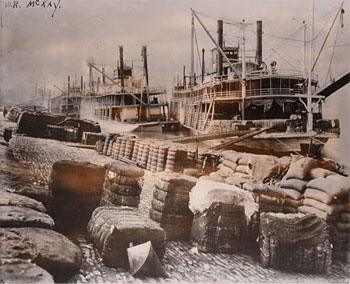
[more]
thanks to gmtPlus9
budgets
For Budget Director, No Red Ink and the Skies Are Not Cloudy All Day
|
The spending plan Bolten outlined was a model of fiscal responsibility. But as he fielded questions for an hour, it became steadily clearer why the new budget seemed so restrained: The White House left out a lot of expenses the government is likely to have, while including savings the government is unlikely ever to see.
For example, Bolten granted that it is certain that more money will be needed for Iraq and Afghanistan in 2006 and beyond. "But," he added, "it wouldn't be responsible for us to take a guess at what those costs are."
Yet, moments later, Bolten explained why it was perfectly responsible to guess about new revenue from drilling in the Arctic National Wildlife Refuge -- even though such a program has not been approved by Congress. "Well," he said, "the budget is the right place to present the entirety of the president's policies, so all of his proposals are reflected in there."
The theme repeated itself throughout Bolten's briefing: Potential good news was embraced, and potential bad news was left out of the equation. How about the hundreds of billions of dollars the government would borrow to convert Social Security to personal accounts under Bush's plan? Not included. "The budget went to bed . . . before the president's proposals were announced," Bolten explained.
| |
[more]
thanks to Bad Attitudes
photography
The Street Dentist
|
Amjad Mia, a Fifty-five years old self taught dentist, sits on the footpath to attend his patients. This is an everyday scene for the people of Saver bazaar, approximately thirty kilometers away from Dhaka.
| |
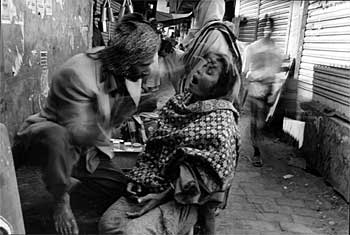
[more]
journalism, politics, and food
Tomgram: Following the Food Chain with Michael Pollan
|
About labeling, but also, before that, about whether we should even approve this technology. The reason there was not a fight is because both political parties were on board for it. The Republicans were predictably pro-business and anti-regulation. And the Democrats had allied themselves with the biotechnology industry, had picked it as one of the growth industries in the early 1990s. Also, the biotech industry, in the person of Robert Shapiro, the president of Monsanto, was very close to Clinton and his administration.
The key moment, when the rules and regulations were being decided for the industry, came at the end of the first Bush administration and the beginning of the first Clinton administration. Both parties agreed that the industry should proceed with as little regulation as possible. The result was that biotech was introduced with no political debate and remarkably little journalistic attention.
The larger meaning here is that mainstream journalists simply cannot talk about things that the two parties agree on; this is the black hole of American politics. Genetically modified crops were in the black hole until the Europeans reacted so strongly against them; then we began to have a little bit of politics around the issue, but still not very much. The things journalists should pay attention to are the issues the political leadership agrees on, rather than to their supposed antagonisms.
| |
[more]
heavy medal
The Soviet Military Awards Page
|
"Dedicated to providing quality information about the military and labor awards of the former Soviet Union...."
| |
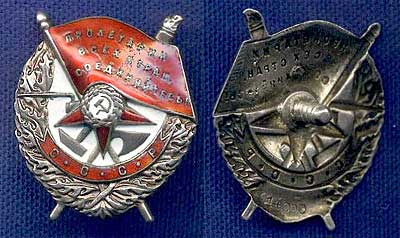
Order of the Red Banner
[more]
thanks to plep
lefty blogs
Anyone who has read this blog probably noticed that it leans to the the left. Well, this isn't the only one. Kevin Hayden put together this list of lefty blogs. I've mentioned it before but he has added a bunch more to it. I happen to be on the list. I'm honored. I'm proud to be associated with these fellow travelers.
States Writes: the Progressives' Peer Directory from the American Street
|
If you're a reader who wishes to gain a cross section of news and opinion at international, national, and local levels, try reading through the blogs and news sites in your home state section, for the local. For the national, go to the Topics section. Most of the news sites and news aggregators are in the left, red column. You'll also find world media and blogs from around the globe there. In the right (blue) column, try the 'Top 50 progressive blogs' and the group blogs. It'll take a couple of weeks perhaps, to wade through them all, but after the first time through, you'll be able to create your own shortlist from those sections to visit after that.
| |
[more]
the frankenloupe
Focusing on a view camera is done on ground glass and close focusing requires a magnifying device called a loupe. For years I used a cheap plastic one like this...
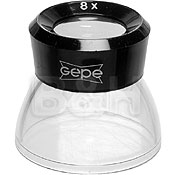
Only a small part in the center was sharp and the rest of the image was pretty funky. Lately I've been using a linen tester...
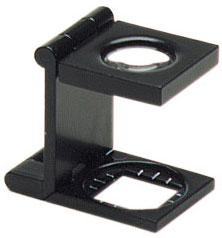
A big improvement but you still have to put your face close to the glass and your eye close to the magnifying glass and it's metal which isn't the best on glass. Recently, Marja-Leena sent me a couple of lenses from a process camera. One of them, the Comparon, wasn't useful as a taking lens but a post on a large format forum mentioned it would be useful as a loupe. I did some looking through it and then went down to the local Ace Hardware and hung out in the plumbing department looking through pieces of plastice until I found the right combination that would put it off the glass the right amount to be in focus.
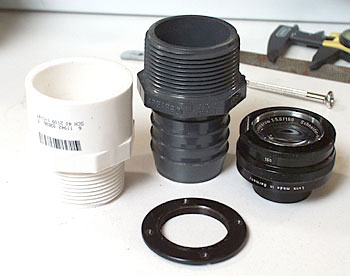
Two plastic pieces of plumbing, the mounting ring, and the lens. Add a little 5-minute epoxy and voila! The FrankenLoupe...
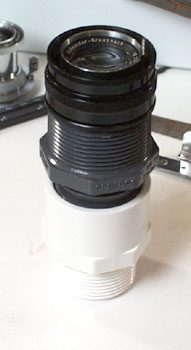
The mounting ring is bonded to the plastic and the lens screws into the mounting ring. It's nice and long which solves a big problem. Both my 5x7 back and my 4x5 back have hoods which would have made using the linen tester impossible. This will work fine with the hoods. It doesn't have a high magnification but it has a nice wide field and I can see it quite well with my eyes back from the lens. I think this will work out very well. Now I need to make a neck strap for it.
when cameras are outlawed, only outlaws will have cameras
A Cautionary Tale: The Investigator Calls…
If you make photographs outdoors, you have to read this.
|
He arrived early in the morning, dressed in civilian clothes rather than a police uniform.
He introduced himself to our staff, presented his card, badge, and official identification. He had traveled some distance to visit NYI, and he had a reason. It appears that one of our students had been observed taking photographs along a highway one evening. He was crouched low, alongside some bushes. Witnesses who saw what the photographer was doing became concerned, and one of them approached the student, who answered that individual’s questions and even presented his NYI Student Identification Card.
Despite the fact that the student had been fully cooperative and had explained that he was working on his first Photo Project, and had even shown his questioner his student ID card, the people on the scene were not satisfied.
And so a complaint was filed. In fact, the complaint was filed with the New York State Counter Terrorism Task Force. That complaint was referred to the Investigator, and hence, one clear, blue sky morning in New York City, the Investigator called.
| |
[more]
thanks to Conscientious
light measuring unit
My little Sekonic L-136 light measuring unit arrived yesterday. And it is little.
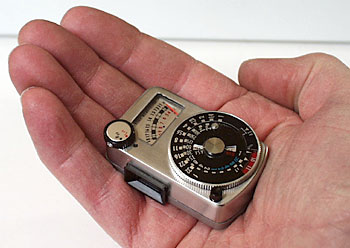
I've been using my handheld Luna Pro. It's not going away but an on camera meter is much handier. And did I say it was little?
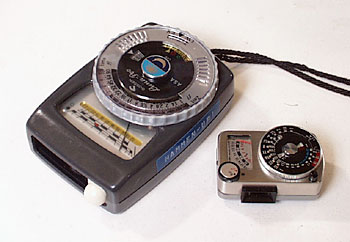
It mounts on the accessory shoe. It's a tight fit but it looks real nice on the FED. Unfortunately, it won't fit on my Zorki 6. The Sekonic isn't that little. This may mean the Zorki 6 may be finding another home. I think the FED and Sekonic will make a very nice combination. Unfortunately, it will have to move when I need the Universal Finder for my 35 and 85. I looked at the double accessory shoes at Cameraquest but it would be too big for this camera and I'm not sure there is enough room for the Universal Finder and the Sekonic anyway. Oh, well. It will still be easier to carry around.
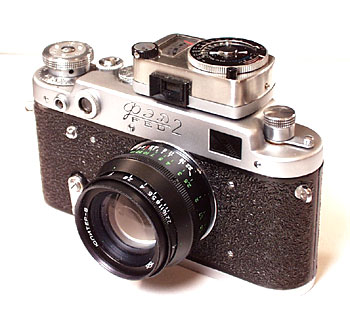
It fits very nicely on the Flexaret Va, too.
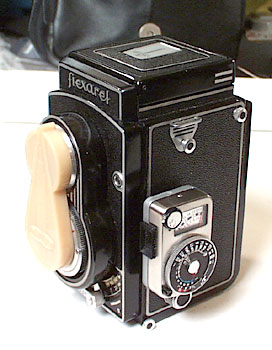
And it came in the coolest little wooden box.

Sweet, sweet, sweet!
|
|
|
|




















